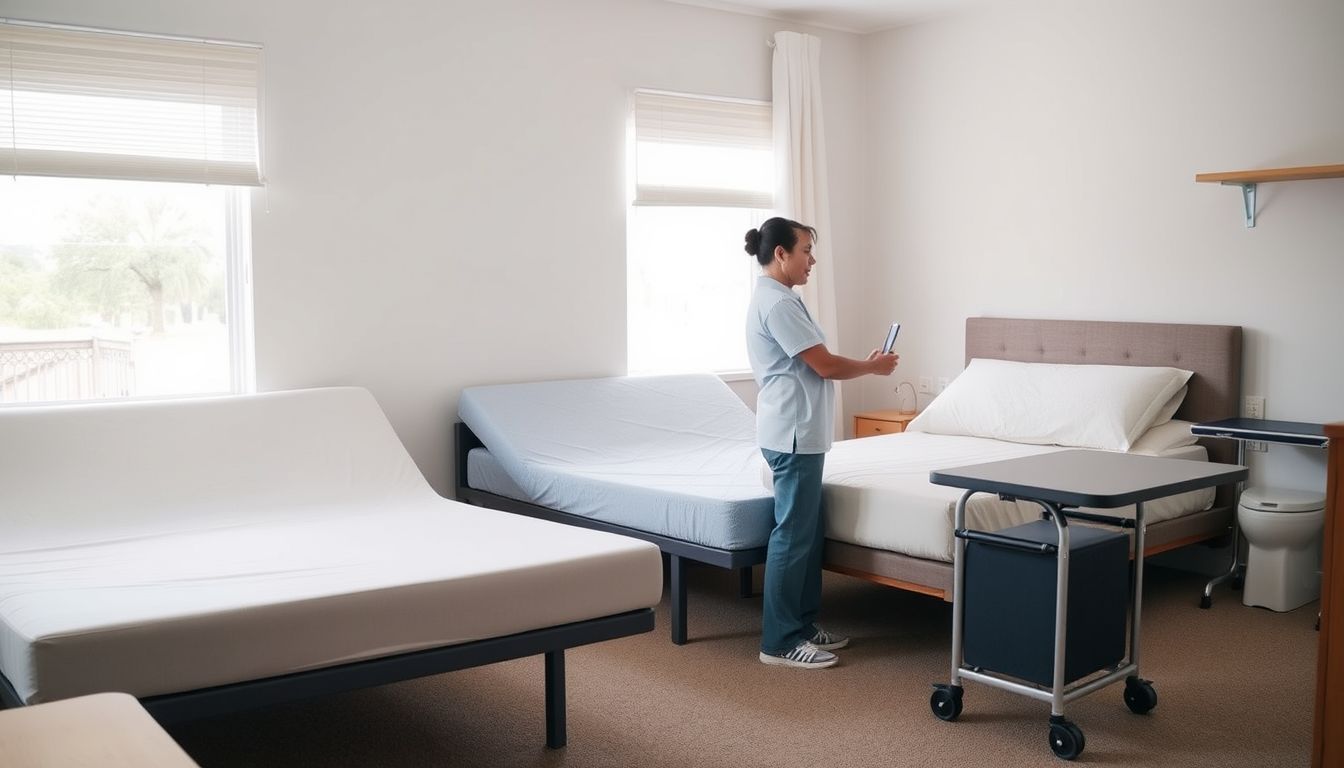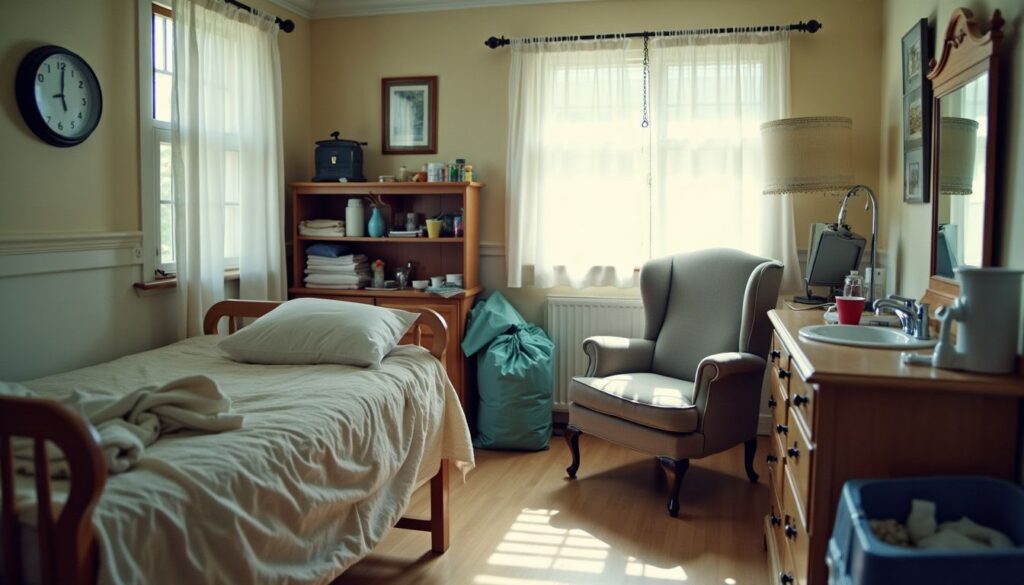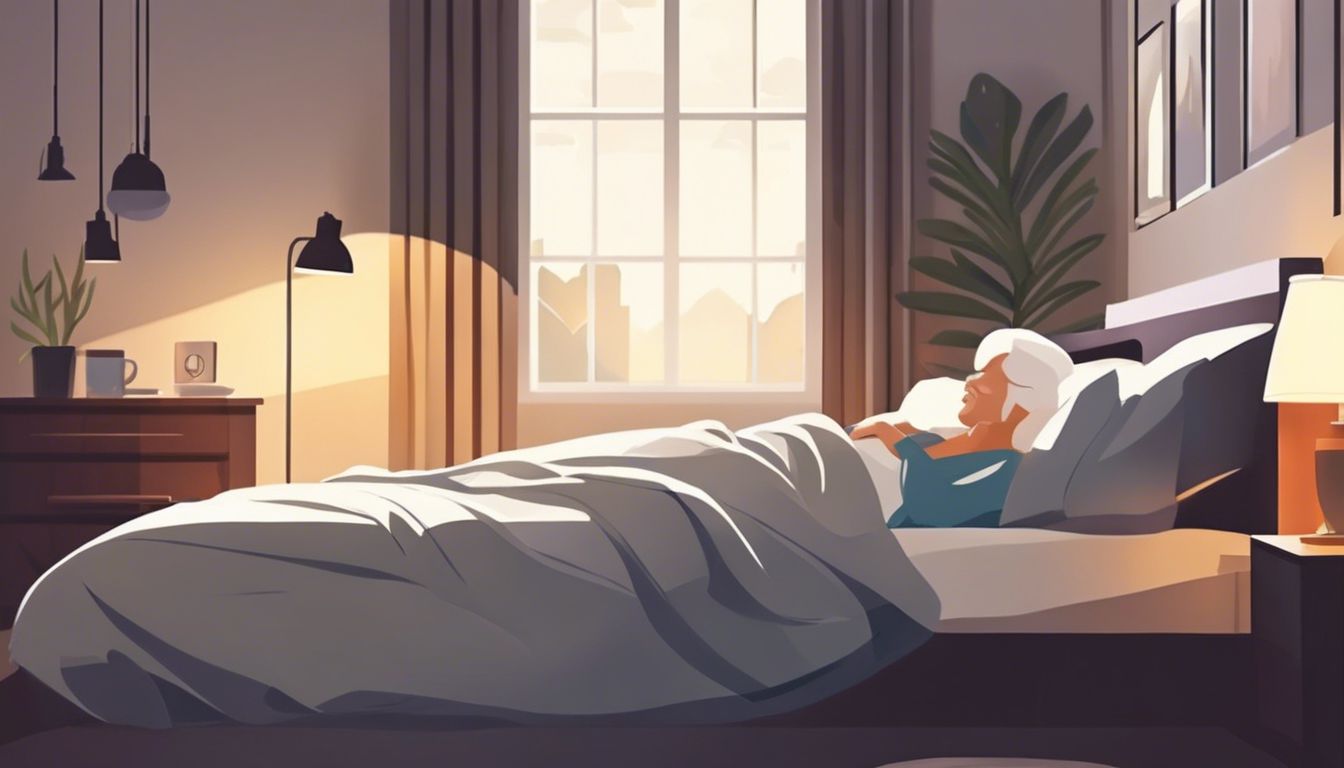Caring for someone at home is tough. One fact stands out: the right bedroom items can make a big difference. This article lists essential items that boost comfort and safety. Read on—it helps a lot.
Key Takeaways
- Adjustable beds help change the person’s position to prevent falls and improve comfort.
- Support rails, beside grips, and stepstools make moving safer, especially at night.
- Bedside commodes reduce fall risk by being close to the bed for easy toilet access.
- Overbed tables keep meals and care items within reach, making personal care easier.
- Mattress toppers and high-quality mattresses offer extra comfort and better sleep for caregivers.
Essential Bedroom Items for Caregivers

Caregivers need tools that make caring for others easier and safer. Essential items include beds that move, grab bars, portable toilets near the bed, tables that roll over beds, soft mattress covers, and supportive mattresses to improve sleep and care.
Adjustable Beds
Adjustable beds are a must for caregivers. These beds make it easy to change the position of the person being cared for. This can help with comfort and medical needs. For example, adjusting the bed can prevent falls—a big risk since 1 in 4 older adults fall each year.
Support holds like rails fit well with adjustable beds. They add extra safety when moving or sitting up. Plus, these beds work great with mattress toppers and high-quality mattresses for added comfort.
It’s clear that having an adjustable bed improves care at home.
An adjustable bed is key in a caregiver’s toolkit, helping manage comfort and reducing fall risks.
Support Rails
Support rails are a must for safety in the bedroom. They help to cut down on falls. You can put them along the bed or near bathrooms. People use grips and stepstools with rails for extra steadiness.
This makes moving around much safer, especially at night.
Rails offer support when getting into or out of bed. They also help when using the bathroom or moving about the room. With these tools, both caregivers and those they care for have less worry about slips and falls.
Bedside Commodes
Bedside commodes are a must-have for safe night care. They cut down the risk of falls by making it easy for those in bed to use the toilet without going far. This handy item keeps trips to the bathroom short, especially at night.
It’s clear, having one next to the bed is key for safety and ease.
These portable toilets help a lot with personal care, especially if moving is hard. They make life easier not just for those being cared for but also for caregivers. By using bedside commodes, caregivers can manage nighttime care better without worry about accidents or falls.
Overbed Tables
Overbed tables make mealtime and getting to items easy for those in bed. They help both caregivers and those they care for. This table is key for keeping personal care items, medication management tools, and first aid kits close by.
It makes sure everything needed is at arm’s reach.
Easy access to essentials makes caregiving smoother.
These tables are great because they roll over the bed or chair. This means less moving around for the person in need. Overbed tables can hold books, meals, hand sanitizers, and more.
They improve wellness by making personal hygiene tasks simpler right from bed.
Mattress Toppers
After choosing the right overbed table, consider adding a mattress topper for extra comfort. These toppers help reduce pressure points, which can prevent bedsores. They are key in making sure anyone lying in bed for long hours stays as comfortable as possible.
For caregivers focused on self-care, this simple addition can make a big difference.
Mattress toppers come in various materials like foam or gel. Both types work well to enhance comfort in hospital beds and regular beds too. They’re easy to set up and take care of, which helps caregivers save time and effort.
Adding a high-quality mattress cover will also keep the topper clean and extend its life, ensuring the person you care for gets better sleep and support every night.
High-Quality Mattresses
High-quality mattresses make a big difference in sleep. A 2018 study shows they help caregivers sleep better. Good sleep is key for their health and well-being. These mattresses support the body right and cut down on tossing and turning.
They also reduce pressure points, which can cause pain.
Choosing the right mattress matters a lot. Look for ones that fit the caregiver’s weight and sleeping style. Also, consider ones with materials that keep you cool if you get hot at night.
Some even have covers that you can wash, helping keep things clean and germ-free, important when caring for someone with health needs.
How to Choose Ergonomic Furniture for the Caregiver’s Bedroom
Self-care is crucial for caregivers, and the choice of bedroom furniture can significantly impact the caregiver’s productivity and comfort.
- Consider adjustable beds that can provide enhanced relaxation and ease in waking up.
- Opt for easy-to-install and -operate support rails, which can make entering and exiting the bed safer.
- Select bedside commodes that best fit the room and can help avoid night-time trips to the restroom.
- Prioritize overbed tables with variable heights, simplifying in-bed activities like eating and reading.
- Think about investing in premium mattresses that promote sound sleep and mitigate backaches.
- Consider mattress toppers for extra comfort—they can potentially assist in pressure relief.
- Prioritize items that are simple to clean—especially with disinfectant wipes—to maintain a hygienic environment.
- Aim for furniture that matches the caregiver’s stature and reach for more efficient task completion.
- If space is a constraint, consider designs that save space, like wall-mounted or foldable items.
- Cross-verify online reviews before any purchase, taking into account feedback from other caregivers.
Ergonomically sound furniture helps caregivers and also elevates the standard of care for their loved ones at home.https://www.youtube.com/watch?v=Bmr8nQlXLuM
Benefits of Having the Right Bedroom Equipment
Having the right bedroom gear makes caring for someone easier, safer, and more comfy. It helps those in care move around better. This means caregivers can do their job well without extra stress.
Read on to see how these tools can change things for the better.
Enhances Comfort and Safety
Safety tools such as bed rails and grips adjacent to the bed ensure prevention of falls. They are exceedingly helpful, particularly during nighttime when mobility can become hazardous.
These tools bring about tranquility for both the caregivers and their care recipients. With reduced apprehension about falls, everyone achieves better sleep.
Optimal mattresses are also vital. They promote the caregiver’s restfulness and health improvement. When sleep is restful and serene, caregiving during daylight becomes more effortless and secure.
Moreover, the presence of medical equipment like blood pressure monitors simplifies health monitoring without inducing tension or surplus activities into a hectic day.
Facilitates Easier Caregiving
The right bedroom items make caregiving tasks simpler. For example, overbed tables put meals or books close to the person in bed. This means caregivers don’t have to move things around a lot.
Bedside commodes save trips to the bathroom at night, cutting down falls risk. These tools let caregivers give better help with less moving and lifting. They make sure safety while making daily tasks like eating and personal care easier for both caregiver and person taking care of.
Improves Patient Mobility
Adjustable beds and support rails make it easier for patients to move. These items help people get in and out of bed safely. They also let caregivers adjust the bed to the right position for health needs, like helping with blood flow or breathing.
This means patients can change how they sit or lie down without much help. It leads to more independence and lowers the chance of falls.
Next, tools like stepstools add an extra level of safety for moving around the room. With these small steps, patients have support when they need to reach something high or get into bed.
Each tool plays a part in making daily tasks smoother and safer for everyone involved. Now, let’s look at how choosing ergonomic furniture can benefit the caregiver’s work area.
Conclusion
Caregivers need the right bedroom items. Adjustable beds, support rails, and bedside commodes help a lot. Overbed tables make eating easier. Good mattresses and toppers add comfort.
These tools improve care, safety, and movement for those they look after. It’s clear—choosing these essentials changes lives for caregivers and those in their care.
FAQs
1. What are some essential bedroom items for caregivers?
Caregivers should have incontinence supplies, a first aid manual with antibiotic ointment, and adaptive clothing for those they care for. A transfer bench can be helpful, especially during showers.
2. How can technology assist caregivers?
Technology like telehealth services, personal emergency response systems and wearable devices such as smartwatches can help carers monitor health data and manage emergencies effectively.
3. Why is protective gear important for caregivers?
Protective gear helps to prevent hazards while caring for patients with illnesses like Alzheimer’s or dementias. It also promotes good hygiene practices like handwashing.
4. Are there financial aids available to cover caregiving expenses?
Yes! Caregivers may apply for a personal loan or use an FSA (Flexible Spending Account). Some of these expenses could even be tax-deductible…check with your healthcare provider!
5. Can apps help in eldercare management?
Absolutely! Apps provide access to video calling medical professionals, learning about diseases like undernutrition or malnutrition, stress management techniques and more…
6. Is empathy crucial in caregiving?
Indeed it is! Empathy plays a significant role in understanding the needs of the person being cared for – it’s not just about providing physical assistance but emotional support too.









